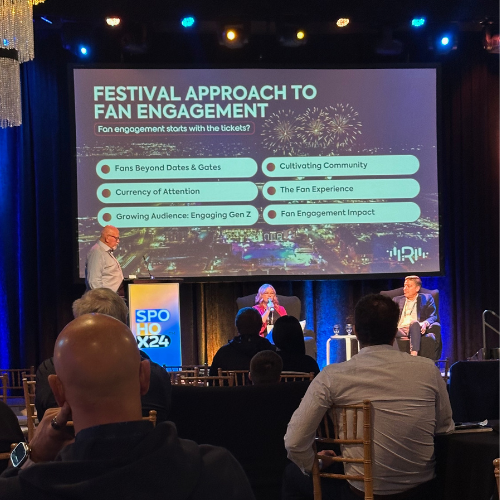By Angela Kryhul
In today’s fast-evolving sports landscape, engaging fans goes beyond the game itself. A panel of industry experts recently explored the dynamic world of fan engagement, sharing insights on how to captivate audiences before, during and after games.
Taking place during Spo Ho Xperience, held October 28-29, 2024 in Charlottetown, PEI, the panel offered valuable takeaways for creating memorable, shareable moments that encourage fan interaction and social sharing.
From the rising expectations of fans to the transformative role of technology and immersive experiences, they highlighted strategies that enhance the overall sports tourism ecosystem.
Speakers
Kim Doyle, founder, chief experience officer, Resonate XM
Chris Larsen, president, Sports & Entertainment Atlantic, and panel moderator
Mike Morreale, commissioner and co-founder, Canadian Elite Basketball League (CEBL)
Simple actions can make a big difference
Mike Morreale: One of the simplest ways that we create memories for young fans is to conclude each game with an autograph table where players sign Spalding-branded autograph cards. These touch points don’t cost money or take any technology, but they create relationships by breaking down the barriers between the stands and the players.
Kim Doyle: On the ticketing side, consider that not all fans are the same. You’ve got general admission and VIP, but could you also create a general admission-plus ticket? There is an audience that will pay a little bit more for shorter lineups, better washroom facilities and to have food and fan merchandise delivered to their seats. What are the pain points that you can’t fix for everyone, but you can for some people who will pay for and value those experiences?
Create shareable moments and support fan initiatives
Kim Doyle: Think beyond just your event. How can you engage fans before, during and after? And in cultivating that community, how are you able to give more value to your partners and help generate revenue? Gen Z is the largest generation in history. They want that personalized level of experience, and they want to celebrate individuality while being part of the group. They’re not listening to the radio or watching TV. The players and the influencers are the new celebrities. Are you creating memorable experiences that you want them to share? FOMO is real.
Mike Morreale: Engagement with the fans is paramount. Most facilities are made for hockey, not for basketball. So how do we create intimacy within that arena to really provide higher levels of engagement with our fans? Our games have a DJ that plays music throughout our games. There’s constant action and activity utilizing the scoreboards, QR codes and our own people throwing stuff into the stands.
Chris Larsen: Fans of Halifax’s professional soccer team, the Wanderers, created a supporters group organically on their own. It’s not our fan club, it’s their fan club. They gather an hour-and-a-half before the games wearing all the gear, faces painted, banging drums, waving flags, and they march to the downtown pubs to have viewing parties. So you don’t necessarily need a lot of technology, you just need that connectivity to the community, know your customers, encourage them, support them and let them create their own experiences.
Take calculated risks and learn from failure
Kim Doyle: The only failure is not trying. A lot of us try to take calculated risks, but it doesn’t necessarily mean it was a failure. In 2015, at the Cavendish Beach Music Festival, we did RFID wristbands for the first time. We thought we were on the cusp of the technology, but when fans came up to the gate to get and scan their wristbands, each transaction was taking one and a half minutes per person. We had 4,000 people in line, so we just had to abandon it and get them in the gates. RFID is now back and it’s being used at festivals. Be willing to try and take a risk, but also be willing to cut it if it’s not working.
Mike Morreale: In our second year, we were the first to use what is now standard, with AI cameras on the court. I can say it wasn’t a great success in terms of the actual technology, but it was a risk we took. We wanted to dip our toe into some things that were different.
One of the biggest things we ever did was to make a decision to play the FIBA style of game. It can be played in about two hours, it’s fast paced, high energy. But there were a lot of games that ended with fouls and free throws, so it’s not a great end to a game and it’s not a great fan experience. We adopted what’s called the Target Score Time ending, where every game ends on a game-winning basket. Fans feel engaged and have a reason to stay to the end of the game because they believe that every game could end with their team winning.
You can have your traditional ways of doing things, or you take a deeper look at how those things are done and ways that you think you can make them better.
Published November 2024
Read our recent feature article on how to engage female fans.






